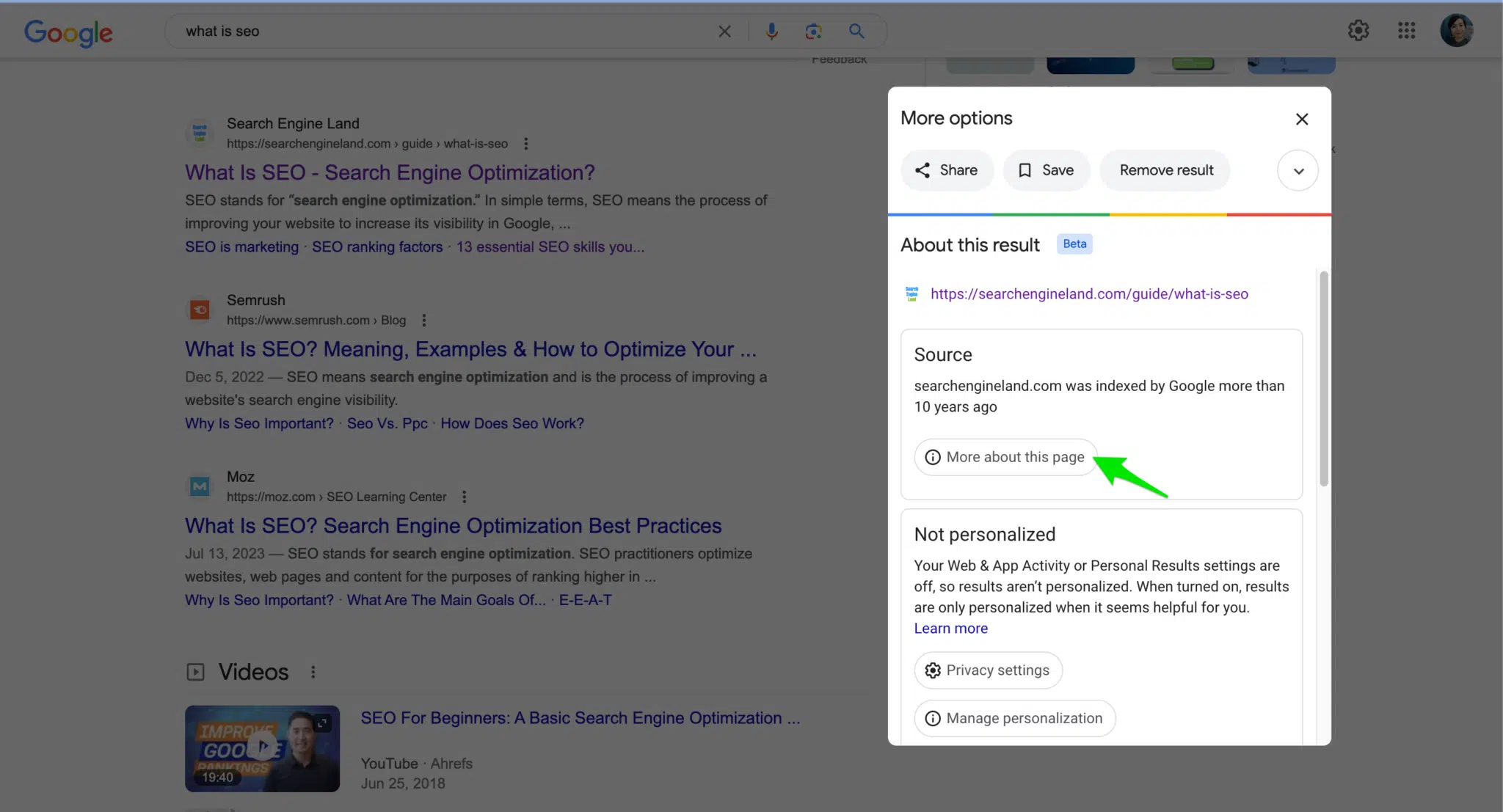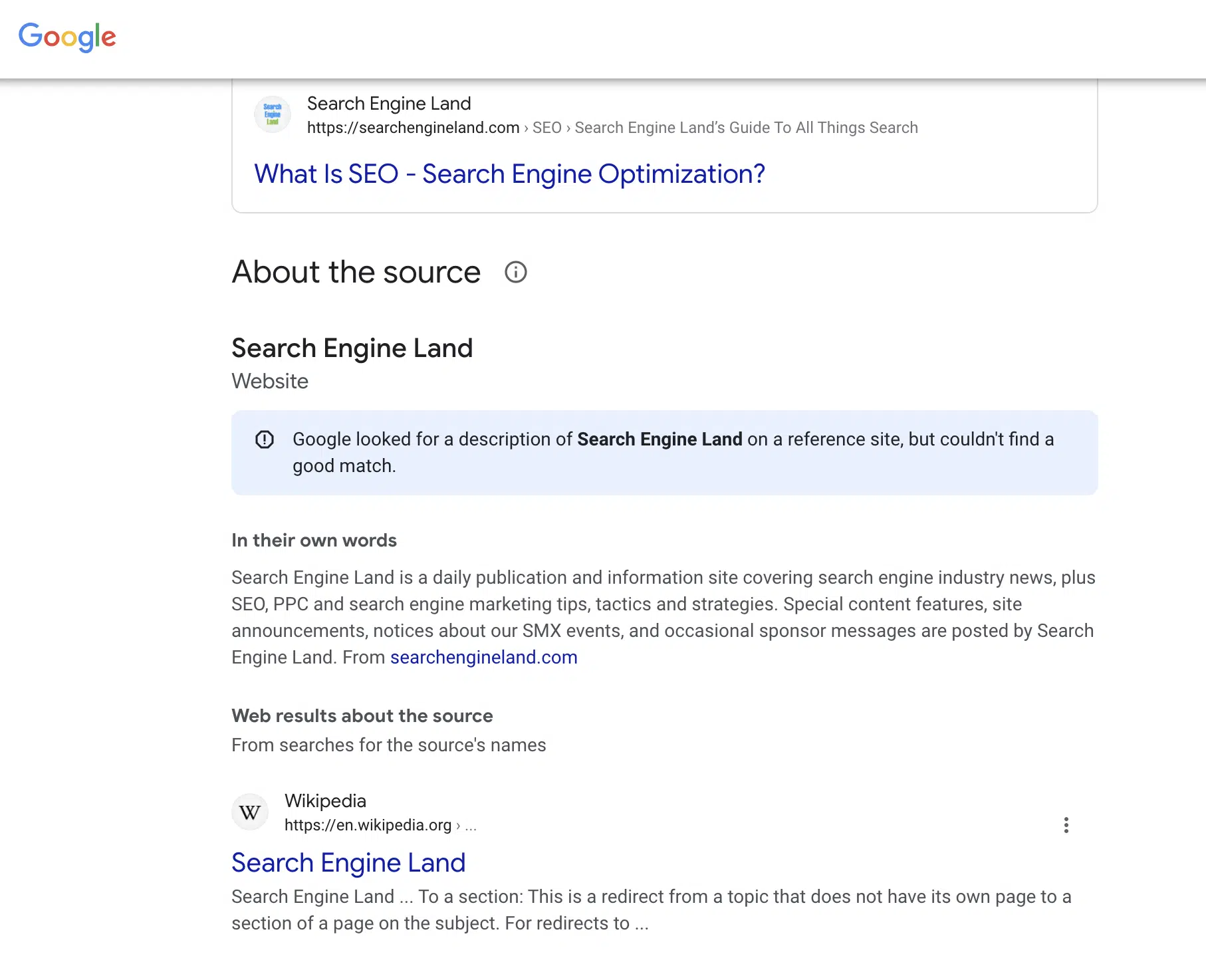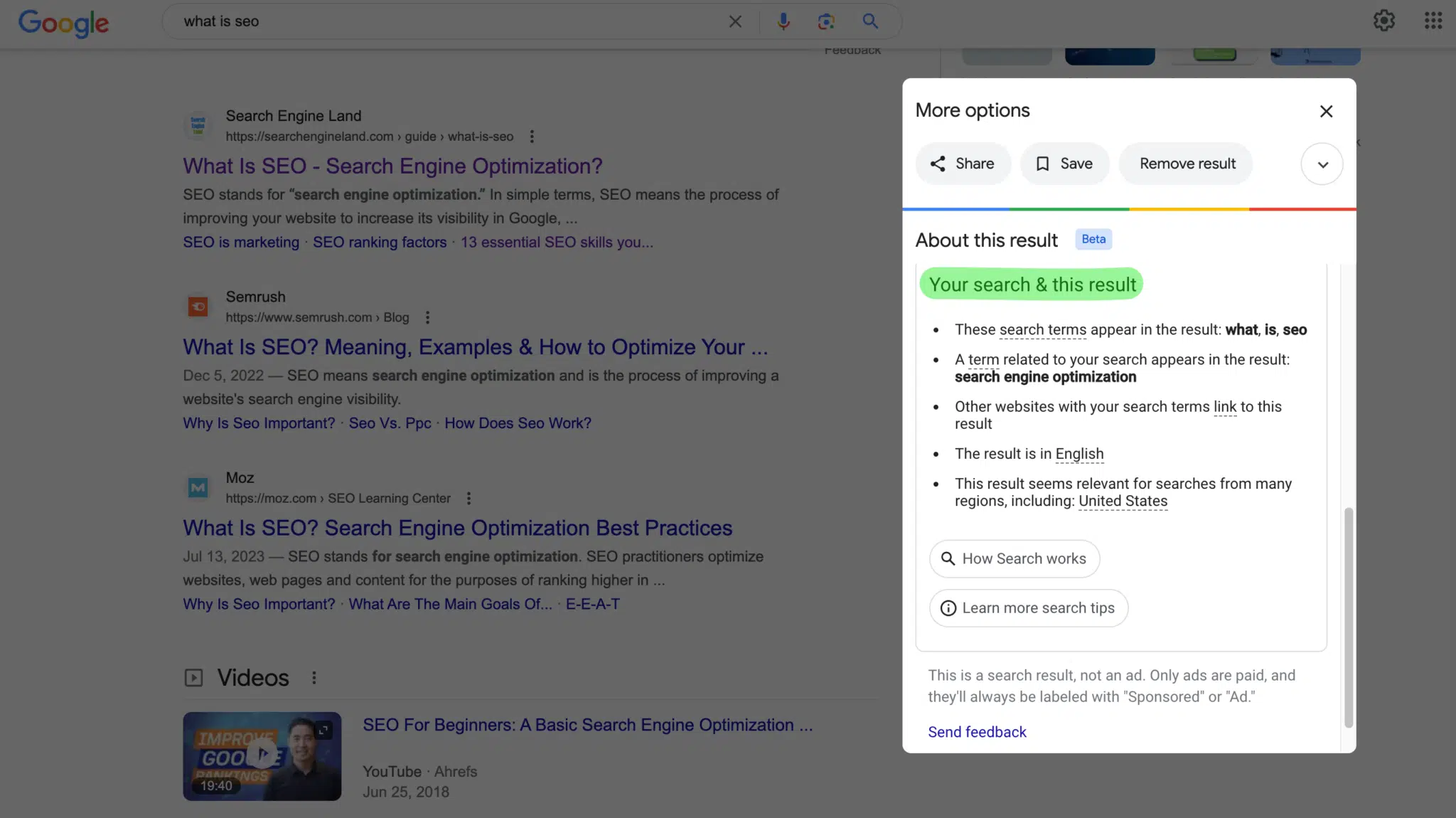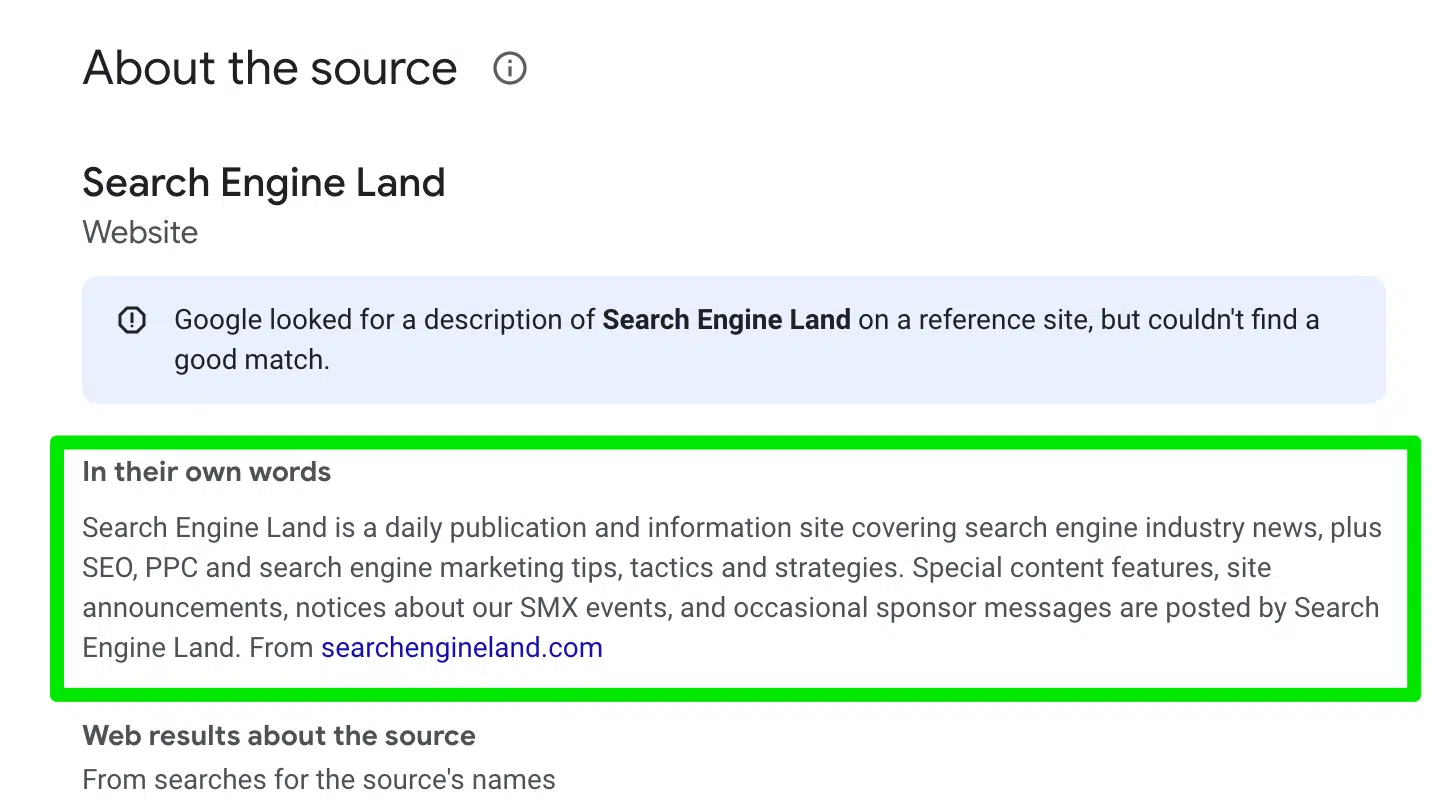How to leverage Google’s ‘About this result’ for SEO insights
Uncover powerful SEO insights from what Google says about your site and competitors and use them to boost E-E-A-T signals on and off-page.
Optimizing for E-E-A-T is challenging because these signals rely heavily on external validation.
Simply proclaiming your own expertise and trustworthiness is not enough. What other sites say about you carries more weight.
This explains the long history of link building in SEO. Links still matter for quantifying E-E-A-T. But amassing links solely for quantity won’t do much for your brand.
The key questions become: Which links does Google see as authoritative endorsements? Which mentions and references from independent sites establish trust?
Understanding Google’s ‘About this result’ feature
We can find out by checking out the sources Google is using with the “About this result” feature.
Here’s a quick way to check what other sites say about you:
- Google your website.
- Hit the three small dots next to your URL.
- On the pop-up modal, hit the “More about this page” button.
- This is Google’s “About the source” page for your site.

This feature provides the following information:
- Site description: Shares information about the site, such as what it is and what it offers – based on the same sources from Google’s Knowledge Graph.
- In their own words: A description of the site/result based on information provided by the source directly.
- Site first indexed by Google: Specifies when the site was first indexed by Google.
- Web results about the source: Provides search results about the specific site/result. These results “are based on a combination of information, including searches for names of the source, to identify pages that may give you context about the website. [They] try to prioritize helpful results that are not created or controlled by the source website, to provide independent perspectives,” according to Google.
This panel offers a unique window into how Google perceives your brand and, more importantly, how your customers see you.
How to leverage this information
This hidden gem launched in 2021 but is vastly under-utilized by SEOs today. This feature helps us understand what information Google relies on for a specific search result and how it is being interpreted.
When doing a search for your brand – or your competition – these are the mentions from around the web that Google has deemed trustworthy.
Here’s how to use these insights to inform strategies for improving E-E-A-T signals.
Inform your content marketing strategy
One of the most significant applications of the “About this result” feature is its ability to inform content marketing strategies.
By examining the sources Google deems authoritative for a particular query, we can gain insight into creating hyper-relevant content that aligns with user expectations and enhances E-E-A-T signals.
Consider the top information sources for your brand by selecting “More about this page” from within the “About this result” panel.


Use this to identify prospective outlets for your content that have already been proven successful based on what Google sees as hyper-relevant and informative.
- Are these the top sources you would expect to see?
- How do they compare to the top sources of your competitors?
- Are there any gaps in your existing content marketing based on what you see for competitor sources?
Guide link building efforts
The feature also offers a window into the world of link building. By understanding the databases and third-party sources Google relies on, you can identify opportunities to strengthen your online presence.
Google is essentially providing a guide for link building efforts by providing insight into the authoritative sources they value.
- What business databases is Google using to gather information?
- Is all of the information in those databases accurate?
- Is Google relying on Wikidata and/or do you need a Wikidata entry?
Use for competitive research
This feature is also great for competitive research. Start by identifying the sites winning featured snippets and appearing in the SGE panel for relevant queries.
From there, evaluate the corresponding “about this result” panels to identify new opportunities both on-page and off-page.
Analyze the information to understand what Google considers authoritative and trustworthy so we can learn from their successes and emulate proven strategies.
- Are there new or indirect brands or companies appearing in organic search to consider competition?
- Are there clear keyword gaps between your site and your competitors?
- What third-party links or mentions are top competitors getting beyond Wikipedia?
- Do your competitors have links from publishers you don’t?
Incorporate into on-page copy
The information Google’s shares in the “about this result” feature can also help us better understand user intent when searching for non-branded keywords related to our content.
We can then tailor on-page optimizations – everything from metadata to content to links – to align with user expectations.
For example, for a broad search for “what is seo” Google shares exactly why Search Engine Land is the top result:

Consider the search terms that appear in the ‘Your search & this result’ section – both those that appear in the result and those terms related to your search that appear in the result. Evaluate how that compares to your site copy.
- Can you do more to reinforce any specific search terms in your site copy?
- Does the competition have high-performing pages you can replicate in a similar or better way?
- Is top-ranking content mostly long-form or short? Does it leverage lots of videos or images?
- For non-branded keywords, what is ranking? Is it mostly product pages, blog posts, or something different?
Share your story
For entities without Wikipedia entries or Google Business Profiles, optimizing the “in their own words” section becomes significant.

An “About” page is a fundamental element of a website. Google recommends leveraging the ‘about-us’ URL slug specifically to provide an overview of your website and brand.
However, much like title tags and meta descriptions, despite this suggestion, Google often does not pull from an “about-us” page – even when one exists.
Google’s recommendations for a description that doesn’t meet expectations are as follows:
- Submit or modify a description for your Business Profile.
- Google will try to find your site’s description on an About Us page. To help Google find the description:
- Create an About Us page on your site with about-us in the URL.
- Include the description of your site on that page. The description must be in English and crawlable.
- Link to that page with the text ‘about us’.
- Include hints like an “About us” header above your site’s description.
So, how and where on your site do you need to have an appropriate description of your business?
- Where on your site, beyond the ‘about-us’ URL does it make sense to include a company overview?
- Where are you linking to the existing “About us” page and with what anchor test?
- What characteristics help make the best description to show how you want to represent your site/brand to Google?
- What should you include to foster familiarity and trust? How can you make an authentic connection with this copy?
Listen to Google’s narrative
It’s not likely the average searcher is using this feature much – but SEOs should be. It is a goldmine of insights.
Beyond the conventional backlink analysis, these insights can shape your content marketing, link building and on-page strategies.
By actively listening to Google’s narrative about your brand, you can enhance your search engine presence and resonate more authentically with your audience.
Everything Google does leads back to providing people with expertise, authority and trust. Make sure your website is doing just that loud and clear.
Opinions expressed in this article are those of the guest author and not necessarily Search Engine Land. Staff authors are listed here.
Related stories
New on Search Engine Land